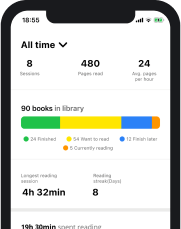Reading is a very common activity, in fact, it is quite essential to most of us. Whether we are enjoying a book, reflecting on a history lesson, praying from a hymnbook, or simply sending messages, in all of these common activities our brain is engaged in the common activity known as reading.
So, in a world where reading is of such importance, it would only seem logical for us to ask ourselves how to read faster. For this reason, in this article, we will try to answer that question while also exploring the concept of speed reading.
What is Speed Reading?
So what exactly is speed reading? It can be seen as the ability to read texts at high speeds while still understanding and retaining their essence. Basically, it’s simply fast reading. We all have books we want or need to read, but it takes some of us much more than others to finish them.
Some people can clear a whole shelf in a year while others are struggling to finish their third book by the time they are writing yet another New Year’s resolution. Learning how to speed read can be a great solution for those of us who struggle to read books faster.
Reading faster is a double-edged sword though. There is a fine line between reading quickly and not comprehending enough of what we read. The ideal scenario for every reader out there would be to find the absolutely ideal reading pace, meaning the maximum reading speed at which comprehension is not compromised.
As you can imagine, finding this perfectly ideal reading speed is not going to be easy, but the good news is that if you follow all of our suggestions below, things are going to be a lot simpler for you.
How to Read Faster?
When it comes to speed reading, there are apparently quite a few things you can take into account to improve your reading. Keep in mind that these tips for reading faster don’t necessarily all work just as well for everyone. Feel free to try them and decide for yourself which of these speed reading techniques actually help and which don’t.
In any case, here are some of the most popular speed reading strategies that can help you learn how to read faster:
1. Stop pronouncing the words in your head (subvocalization)
We all have this habit of speaking the words in our minds when reading them. It comes naturally, but this means that we cannot read faster than we can speak. The solution would be to learn how to read without attributing mental sounds to the words. I haven’t yet mastered this, but they say the way to do it is to look at a word until you no longer pronounce it in your mind when you see it.
Learning how to stop subvocalizing can be tough, especially if you take into account how long you’ve been doing it naturally. Eliminating this habit is going to require a lot of dedication and a very healthy approach, but reading speeds have increased considerably for those who mastered this technique.
2. Learn how to pronounce words correctly and fluently
This is the alternative method, perhaps more accessible, to subvocalization. Instead of doing your best to extinguish your mental wording, observe how you pronounce the words, and jot down the words that make you pause or stutter.
To best figure out which words pose an issue for you, take some sentences and read them as fast as you can. Your tongue will probably get tripped on several words. Go over those words and repeat them until you have them mastered. Afterward, reading them should pose much less of a problem, and you should be able to read the entire text in a much more fluid manner.
3. The skim-through method
It is often recommended that readers have a quick look through the text before beginning to speed read it. This means quickly scanning the page to see what words or elements are most important.
Apparently, this method helps you have a feel and a basic idea of the text even before you’ve begun to read it. This in turn can help you understand it better once you do start pursuing it.
Skimming while reading is a relevant technique that can help those with low reading speeds improve their performance. Through skimming, the reader can get a vague idea of the main ideas and themes of a text they are about to read, which gives them a considerable advantage in terms of reading speed.
4. Disregard the unessential words
Yes, basically, if you really just care to read faster, you can start skipping over words that aren’t really of great importance to the message. I’m referring here to words like “and”, “it”, “are”, and so on.
Obviously, even these words can have great meaning in certain contexts, but often in a sentence there are numerous words that are simply not essential, and thus can be skipped. Sometimes it’s actually easier for readers to skip certain words because it makes the sentence more accessible.
You’ll want to be careful with this advice, however, because you don’t want to get to the point where you’ll start skipping words so often that it becomes a habit, and you find yourself doing it even in writing or when you speak.
5. Use something to keep track of where you are on the page
You can drag your finger or a pencil along the row as you read the words, or even use a ruler placed under the row you’re currently reading. This will help you keep a fluid reading pace and will prevent you from jumping over any rows.
Also known as the “pointer method”, “hand pacing”, or “meta guiding”, this speed reading strategy can help increase your reading speed tremendously if you believe its inventor. Back in the 1950s, Evelyn Nielsen Wood, one of the pioneers of speed reading, claimed she could reach a reading speed of 2700 words per minute simply by sweeping a finger under the line she was reading.
An adaptation of this method consists of simply holding a card under each line and moving it further down as you read.
Another variant is the Tracker-and-Pacer Method, which works in quite a similar fashion. What’s different is that instead of holding a card or a ruler underneath the line you are reading, you are supposed to do the tracking using your finger or another object as a pointer. Reading the text as you move your finger or pointer (could be something as simple as a pen) will help you stay more focused on the words you’re reading which, in turn, will increase your reading speed.
6. Stay focused
One good way to do this is to have a reading hour or a set amount of time allocated in your schedule which is designated for reading. In this way, when you start reading, you know there isn’t anything else you should be doing at that moment, and you’ll have fewer distractions.
Also, make sure it is clear to you why you are reading. Whether it’s for personal development, the gain of knowledge, or simply for relaxation, it’s very important to know why you are investing that time in reading. When you clearly know, you will go about it with greater confidence.
7. Keep track of what you read, and how long it takes you
Unless you somehow hold yourself accountable, you won’t be able to accurately track your progress. It’s the same with any activity that requires perseverance. Unless you truly set your mind to it and dedicate yourself, you won’t be seeing your hard work pay off.
Reading apps like Basmo are a great way of keeping track of your reading. You can simply install them on your mobile phone or tablet and through just a couple of taps, you will have a great tool at your fingertips.
Basmo, among many other things, allows you to record your reading time and the number of pages you read in that time, offering you accurate information to help you calculate your average reading speed.
Furthermore, you can test your reading speed while enjoying your favorite books, as opposed to reading random texts on the website test pages.
8. Bionic reading
Invented quite recently by Renato Casuut, a Swiss developer, this speed reading method seems to be the ultimate tool for those who want to learn how to speed read and improve their reading performance.
Bionic reading is based on the theory that anchors or fixation points in the text can help guide the eyes through the reading material quicker, allowing the brain to fill in the blanks without compromising comprehension. The way it actually works is quite simple. Certain letters in every word in a bionic text are bolded, while the rest are left in the regular font.
This is what a bionic text would normally look like. As you can see, each word has a couple of letters written in bold, and these bolded letters actually represent the anchors the user will need to use as guidance while reading. The point of this technique is to allow the brain to use its priorly acquired knowledge to fill in the blanks.
Your brain has the capability to adapt to different reading formats, and exploiting its ability to fill in the blanks when needed increases the reading speed considerably. That’s because bionic reading bypasses to a certain extent the role your eyes play in the process. Instead of using your eyes to read entire words, you focus your eyes on just a couple of letters at a time and allow the brain to do the rest of the work.
9. The Word-Chunking method
If you want to learn to speed read, this is another technique you should definitely consider. While the principle is relatively similar in a sense, the chunking method is, to a certain extent, the exact opposite of bionic reading.
The word chunking method is defined as the process of trying to group words together while reading. Instead of reading each word independently and using each one as a separate entity to construct sentences like we are taught and used to do, word chunking comes with a proposition to actually try and focus on groups consisting of as many words as possible.
Using your peripheral vision, you are supposed to try and focus your attention on groups of words that make sense when placed together. A good start would be to try and read while focusing on three words at a time. Allow me to use a clear example:
(Instead of looking) (at each individual) (word when reading), (group them together) (as the formatting) (of this sentence suggests). (Once you get) (the hang of it), (you will notice) (that your reading) (speed increases significantly). (That’s because you start) (taking advantage of) (your brain’s ability) (to make sense) (of the written language) (in a different, more efficient) (way than you) (are taught in school.)
10. Peripheral vision
While it’s hardly a technique in itself, the use of peripheral vision is of the utmost importance in speed reading. Also called indirect vision, it represents the things we generally see involuntarily, outside the point of fixation, around the thing we are actually focusing our eyes on.
While you are reading this text, you can probably notice involuntarily the color of the background, the fact that there is a heading title above this text, and some other graphics that appear on our website. You can probably notice your surroundings as well, things happening around the screen you are reading this text on. That is your peripheral vision at work.
To really learn to read faster, you absolutely need to take advantage of the way your peripheral vision works. Your brain has incredible abilities, you just need to learn to use them and there is unlimited potential waiting for you just around the corner.
The main idea in speed reading is to manage to absorb as much information in as little time and with as little effort as possible. The goal of learning to use your peripheral vision is to manage not only to read three words at a time as I mentioned in the word chunking section but entire lines at once.
To increase your reading speed, you will need to combine as many of the techniques on this list as possible and they all culminate with implementing the use of peripheral vision, which is going to give you unlimited possibilities in terms of speed and efficiency in reading.
What is the average reading speed?
Many of you want to know how to read a book fast. First of all, we need to know what the crossover point from normal reading to speed reading is. When do we go from being average readers to actual pros?
We’ll take as an average reading speed for adults a number of 250 words per minute. Obviously, the speed with which you can read and remember something depends highly on the difficulty and complexity of that text, but for now, we’ll stick to this number.
What is a good reading speed?
As with any other activity, the more time you spend doing something, the better you become at it. Consequently, some people are better readers than others, and sometimes faster. But being fast is not the only important factor when it comes to reading. Another factor that is of the utmost importance, is comprehending what you read. If you are a fast reader but understand and retain close to nothing, then it doesn’t really help you.
Therefore, in the beginning, a good reading speed is one where you are able to make sense of and remember what you read. With time, practice and experience, you will be able to read texts faster and better than when you began.
While a normal reading speed is considered to be anywhere around 250 words per minute, you may reach speeds up to 500 words per minute. But remember, never compromise understanding in the favor of speed. It is not in your interest.
If you’re looking for ways of improving your level of comprehension, using an app like Basmo can be of great help. It allows you to make notes while reading, to save your favorite quotes from the books you’re reading, which greatly improves your experience.
You will remember more from what you read and enjoy and you will also have a better understanding of the texts you go through.
What are the benefits of speed reading?
It is said that speed reading can help you improve your memory as well as your focus. While reading in general probably has these effects, perhaps speed reading accentuates them.
Another obvious benefit of speed reading is that you can get through the same number of pages in a shorter amount of time, so basically you gain time by speed reading. This may seem unimportant, but if you are a serious reader, averaging at least an hour a day, the speed with which you read can certainly have a big impact on the amount of information you can work through in that one hour.
Conclusion
That’s about it on how to read faster. It’s definitely a good skill to have and can help readers ramp up their reading achievements. However, as with any good skill, just make sure you don’t exaggerate in trying to perfect it. Using caution in your efforts to increase reading speed is always a good idea. As I mentioned before, compromising comprehension is not a risk worth taking when it comes to reading speed.
Reading is a healthy and beneficial activity, just make sure it remains so for you. Think of where you are now regarding the number of books read per year, imagine where you’d like to be, and make a plan.
Set a time interval allocated to reading and respect it. In the beginning, it may be hard, but once you keep at it for a while and persevere, it might even become a lasting habit.If you’re really serious about your reading and you want to improve your speed and efficiency, using a reading app can be a shortcut worth taking into account. If this sounds like something for you, check out Basmo and read all about its benefits and features.







